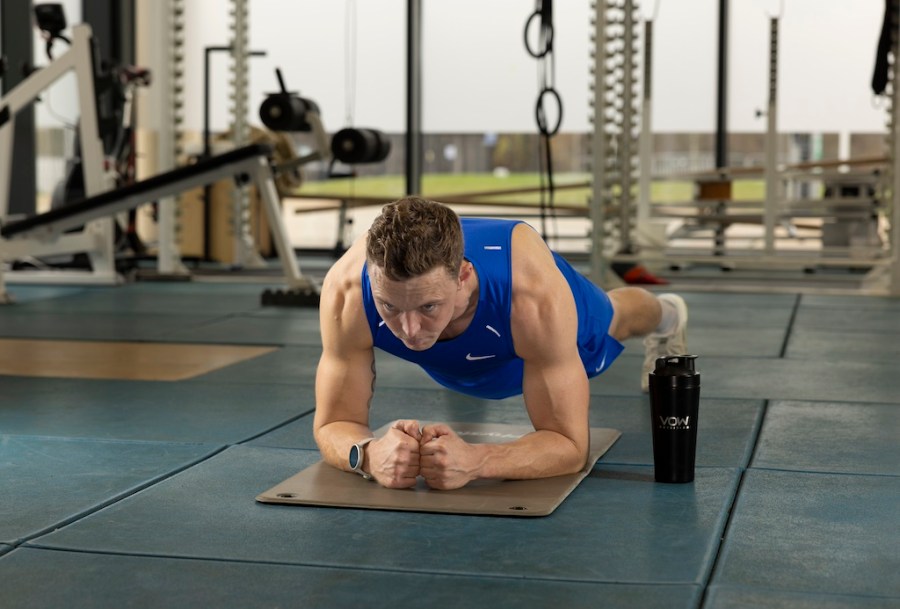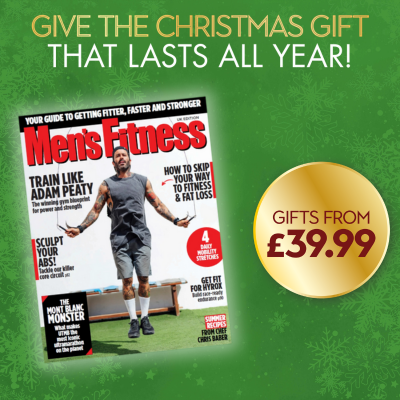Joe Clarke is the gold medal-winning Olympian whose prowess on the water is driven by dedication in the gym. Here’s how his relentless pursuit of power is propelling him towards Olympic glory once again.
Joe Clarke, powerhouse slalom canoeist and VOW Nutrition ambassador, first burst onto the scene with a stunning gold-medal-winning performance at the 2016 Rio Olympics. After that Olympic triumph, in 2018 Clarke bagged his first World Championship title, and despite missing Tokyo 2020 (due to one bad qualifying heat), he has dominated ever since, winning four more kayak cross world titles and European Championships gold.
Having emphatically reclaimed his Team GB spot after the disappointment of Tokyo, Clarke will compete in K1 (an individual kayak race) and kayak cross (head-to-head) in the upcoming Paris Olympics.
Getting race-ready isn’t all about time on the water, though; Clarke also sticks to a disciplined, intense strength training routine to maintain the core strength and upper-body power that’s propelled him to the top of his sport. His week includes two to three gym sessions, each with a strong focus on push and pull elements. Bench presses and pull-ups are his go-to, and he boasts monstrous PBs in both, with a 150kg bench and 85kg weighted pull-up to his name. (He admits, however, that he is that guy who skips leg day – with a medal haul like his, who can argue.)
Strength training is more than just a routine for Clarke; it’s a passion, especially during winter when it’s a great excuse to escape the cold. Depending on his training phase, Clarke’s main lifts – the big, compound exercises at the start of each workout – vary. Early in the off-season, he hits 4 sets of 8 reps, but as the Olympics looms into view he’s dialling it down to 3 sets of 3-5 to sharpen his explosive strength. For supplementary exercises he usually sticks to 8 or 12 reps.
When he’s not pumping iron, Clarke is paddling hard, clocking in seven to eight kayak sessions per week, even more so during the off-season. Winter training means longer sessions in the freezing cold, building endurance and stamina. Strong legs might not be critical for kayaking, but he emphasises the importance of being connected through the hips and core to maximise power and efficiency.
Try Joe Clarke’s upper-body workout
(Read on for a full breakdown of exercises and coaching cues)
- Barbell bench press (4 sets x 5 reps)
- Weighted pull-up (4 sets x 5 reps)
- Barbell bench pull (4 sets x 5 reps)
- Dumbbell shoulder press (4 sets x 8 reps)
- Lat pulldown (4 sets x 8 reps)
- Single-arm dumbbell row (4 sets x 8 reps)
- Seated cable row (4 sets x 8 reps)
- Lying leg raise (3 sets x 12 reps)
- Hanging leg raise (3 sets x 12 reps)
- Triceps rope pushdown (3 sets x 12 reps)
- Dumbbell biceps curl (3 sets x 8 reps)
- Plank (3 sets x 30 secs)
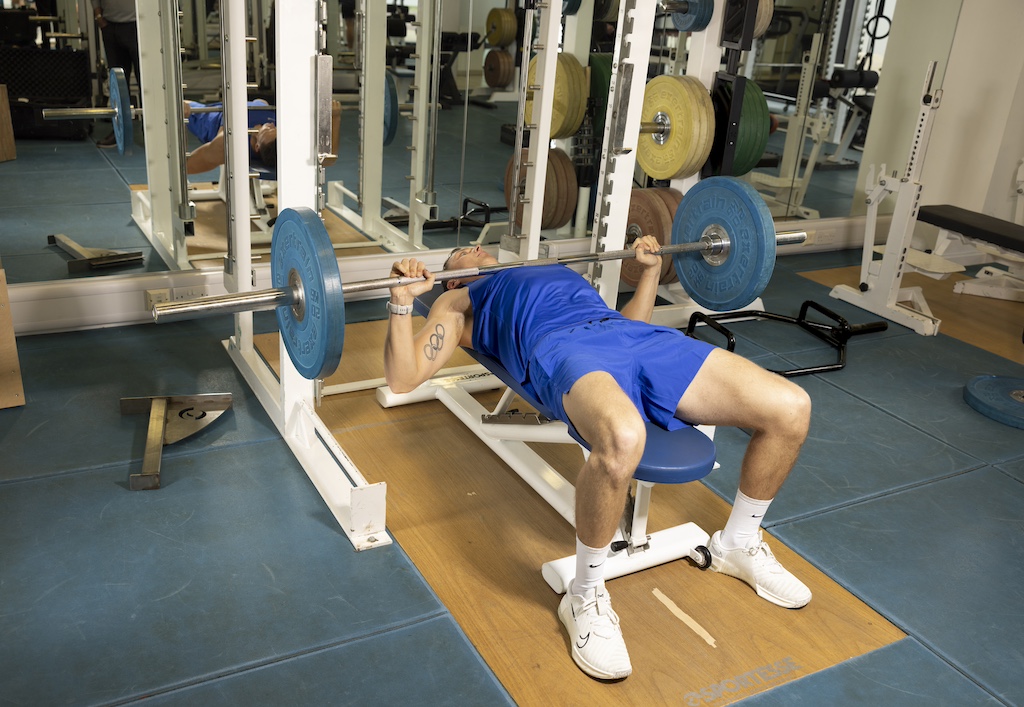
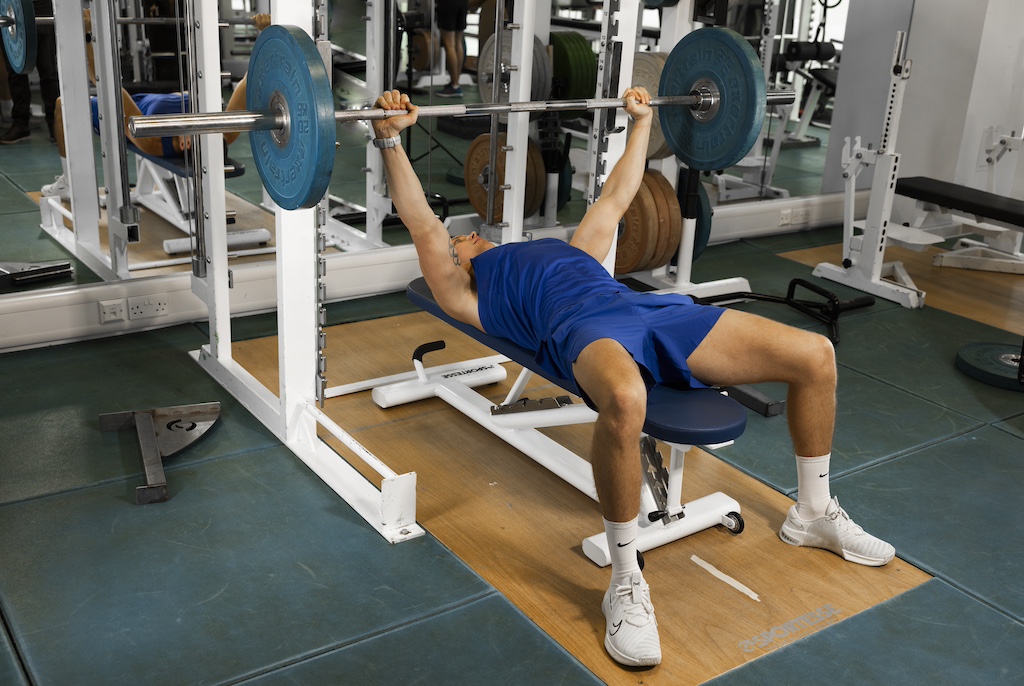
1. Barbell bench press
Reps: 5
Sets: 4
Rest: As needed
- Lie flat on a bench with your gym shoes flat on the ground, arch your back naturally, and grip the bar slightly wider than shoulder-width apart
- Lower the barbell to your mid-chest in a controlled manner, keeping your elbows at a 45-degree angle. Push the bar back up by driving through your chest and triceps, fully extending your arms
- Inhale as you lower the bar and exhale as you press it up. Use a spotter if you’re going heavy
Coaching cue: Drive through your heels and squeeze your shoulder blades together to create a strong, stable base. Keep your chest up and press the bar in a straight line.
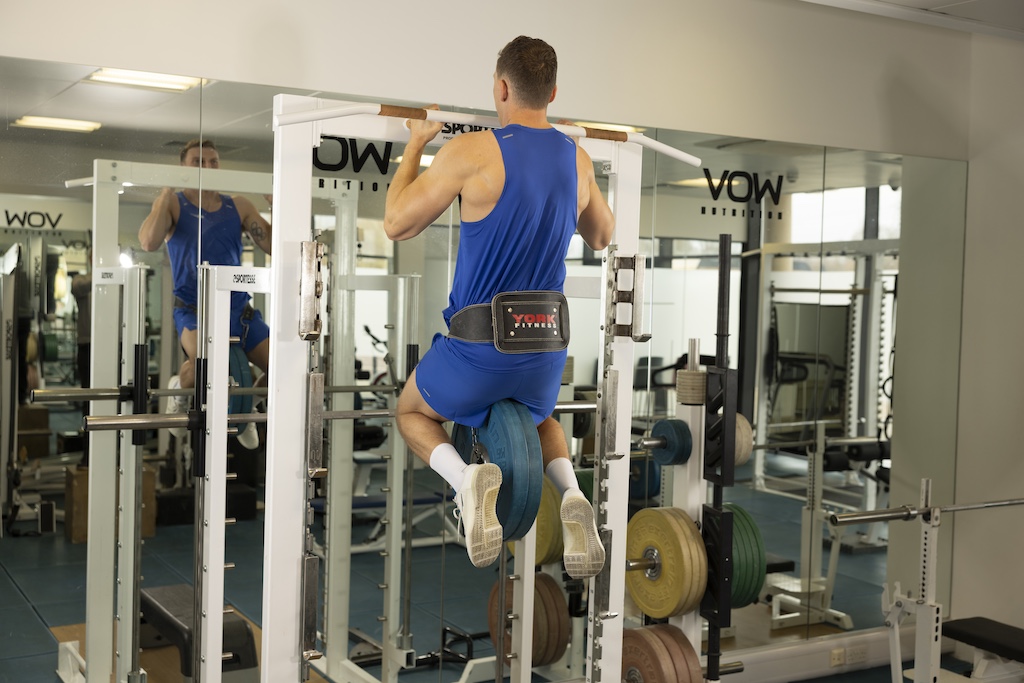
2. Weighted pull-up
Reps: 5
Sets: 4
Rest: As needed
- Attach a weight belt or hold a dumbbell between your feet. Grip the pull-up bar with your palms facing away (overhand grip) and hands shoulder-width apart
- Engage your core and pull yourself up until your chin is above the bar, keeping your body straight and avoiding swinging
- Lower yourself back down in a controlled manner until your arms are fully extended, maintaining tension in your muscles throughout the movement
Coaching cue: Engage your core and squeeze your shoulder blades together as you pull, keeping your movement controlled and avoiding any swinging.
Too difficult? Perform regular or assisted pull-ups if you’re not able to add additional load.

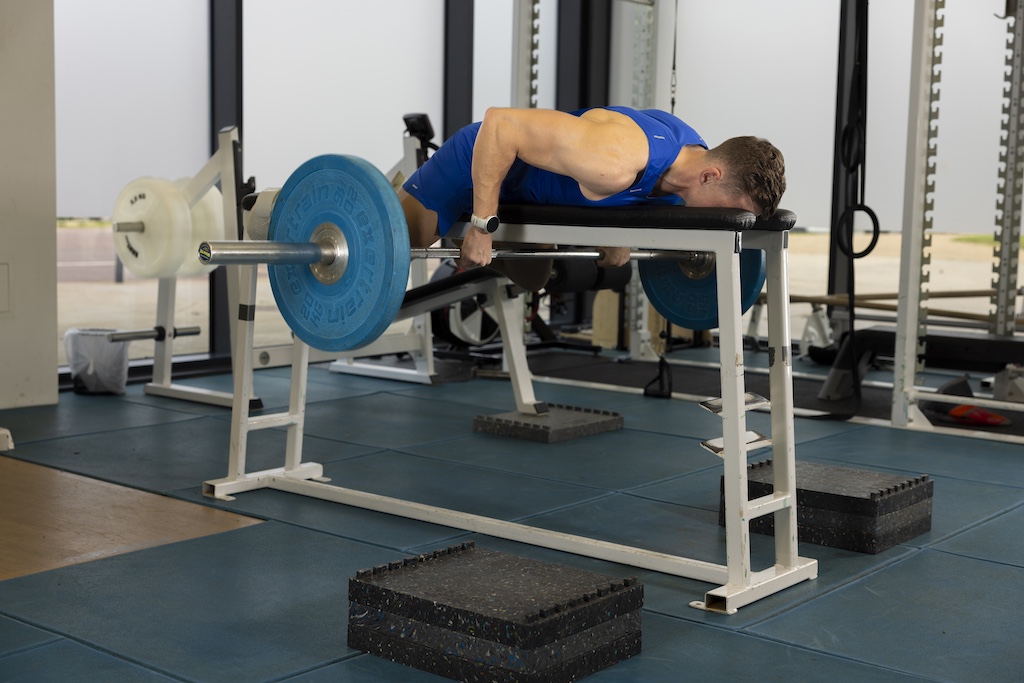
3. Barbell bench pull
Reps: 5
Sets: 4
Rest: As needed
- If you’re gym has an elevated bench specifically for bench pulls, set up on that; if not, set a regular adjustable bench to a 30-degree angle and lie chest down
- Grip the barbell with an overhand grip, shoulder-width apart. Pull the barbell towards the underside of the bench, leading with your elbows and squeezing your shoulder blades together
- Lower the barbell back down in a controlled manner until your arms are fully extended, maintaining a steady and smooth motion throughout
Coaching cue: Keep your chest pressed against the bench and squeeze your shoulder blades together as you pull the barbell up.
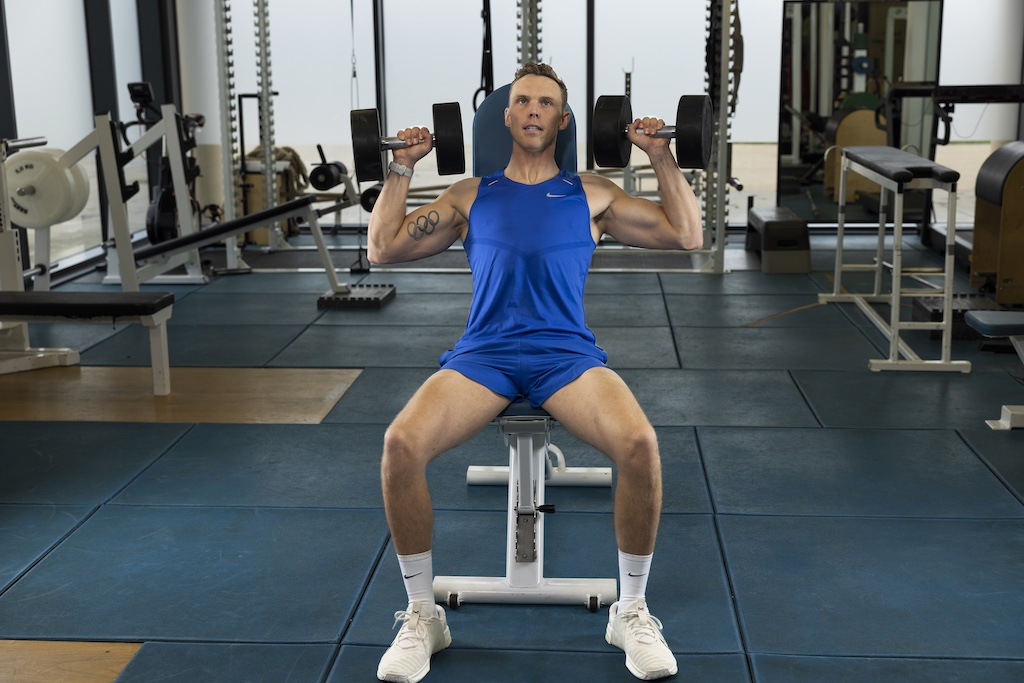
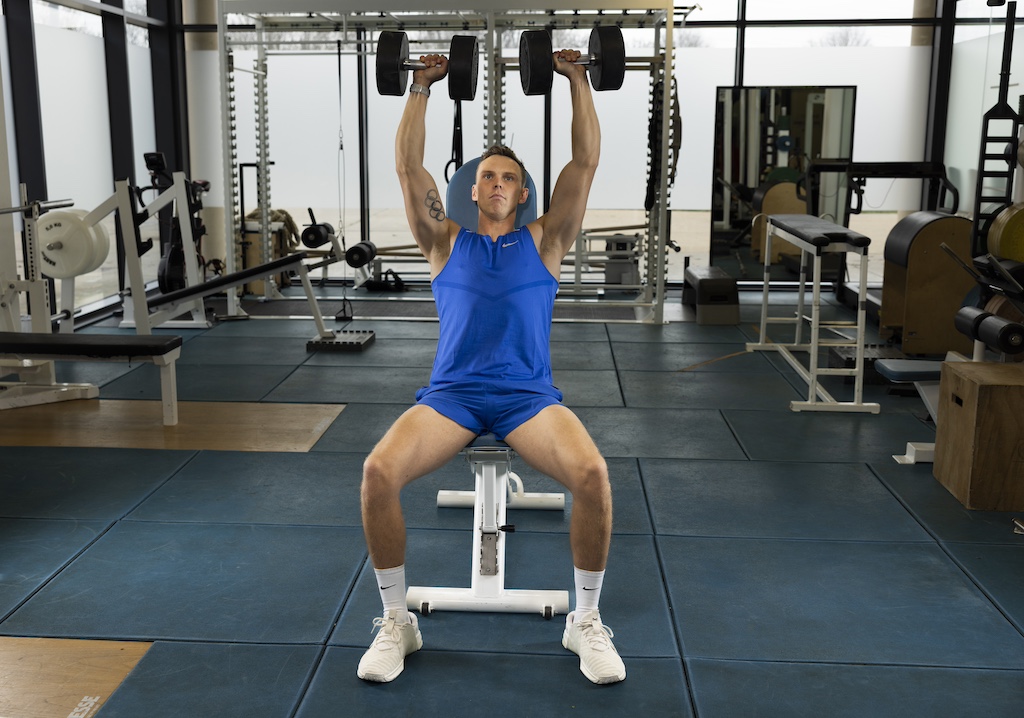
4. Dumbbell shoulder press
Reps: 8
Sets: 4
Rest: As needed
- Grab your best dumbbells, and sit on a bench with back support, holding a dumbbell in each hand at shoulder height, palms facing forward and elbows bent at a 90-degree angle
- Press the dumbbells upward until your arms are fully extended overhead, keeping your wrists straight and avoiding arching your back
- Lower the dumbbells back down to shoulder height in a controlled manner, maintaining tension in your shoulder muscles throughout the movement
Coaching cue: Press the dumbbells overhead in a straight line, engaging your core for stability. Focus on keeping your elbows slightly in front of your shoulders at the top of the movement.
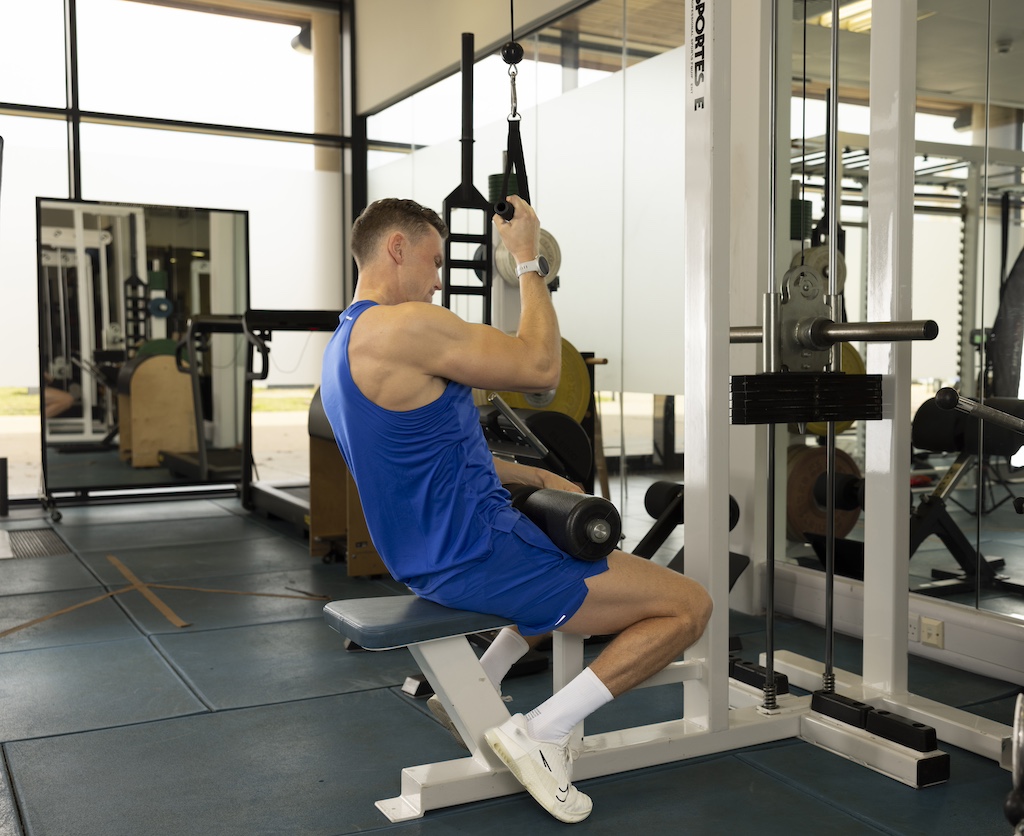
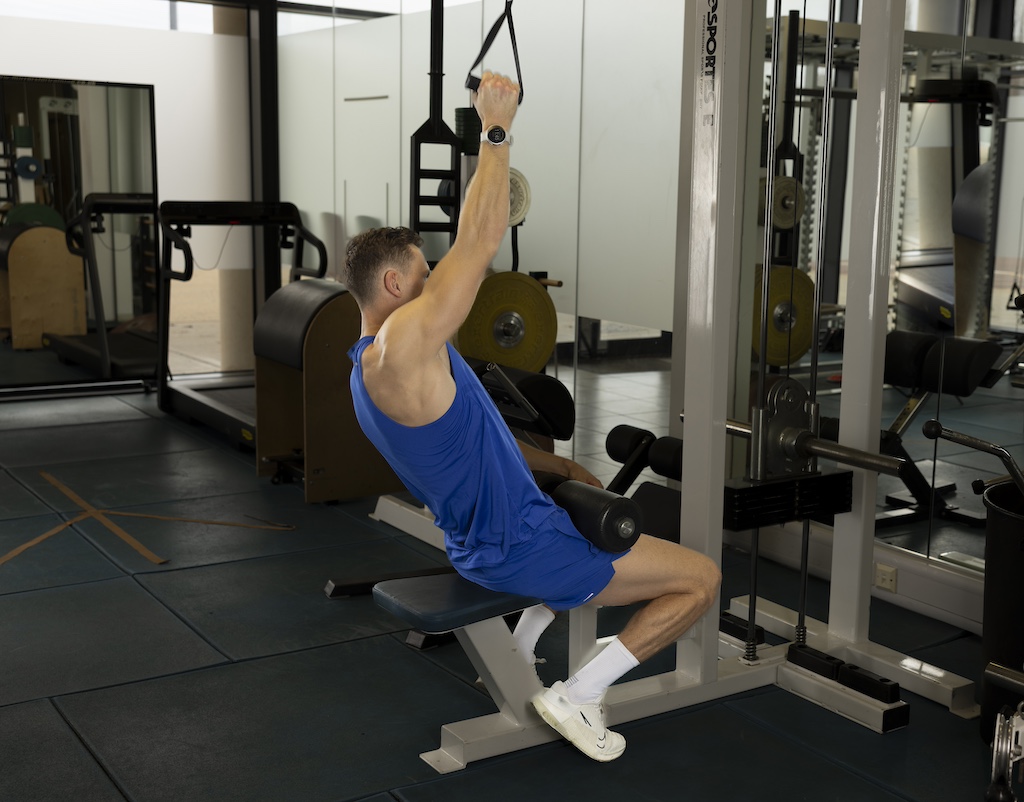
5. Lat pulldown
Reps: 8
Sets: 4
Rest: As needed
- Sit on a lat pulldown machine with your knees secured under the pads. Grasp the wide bar overhead with an overhand grip, hands slightly wider than shoulder-width apart
- Pull the bar down towards your chest by engaging your lats and squeezing your shoulder blades together. Keep your chest up and avoid leaning back excessively.
- Slowly release the bar back to the starting position, allowing your arms to fully extend while maintaining tension in your back throughout the movement
Coaching cue: Focus on pulling your elbows down and back, imagining that you’re trying to tuck them into your back pockets.

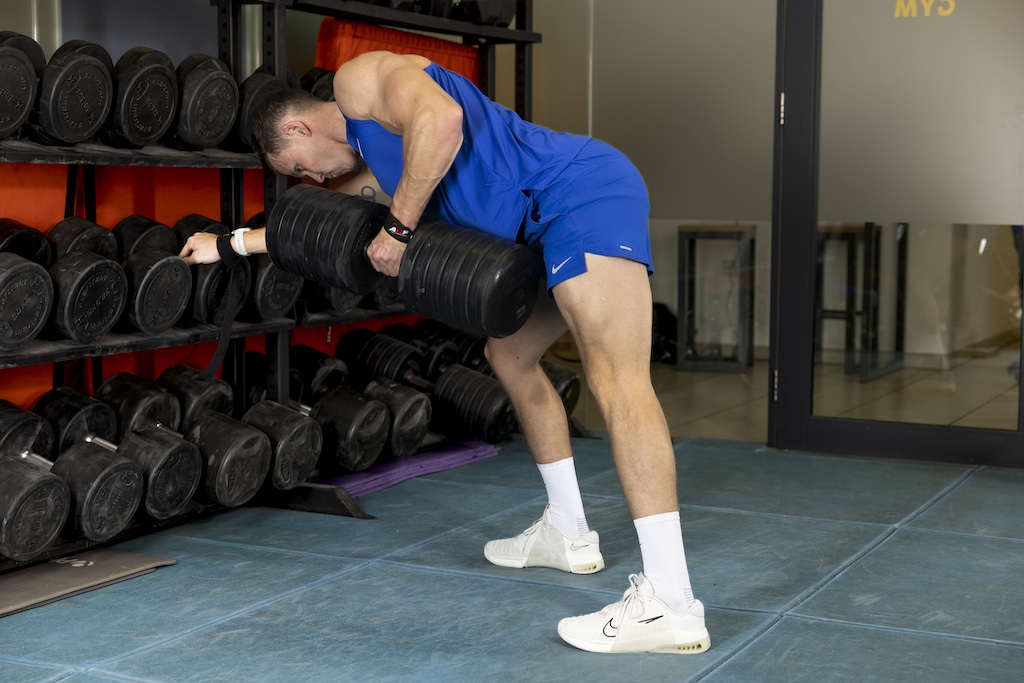
6. Single-arm dumbbell row
Reps: 8
Sets: 4
Rest: As needed
- Stand next to a bench with a dumbbell in one hand. Place your opposite knee and hand on the bench for support, keeping your back flat and parallel to the ground
- Pull the dumbbell towards your hip by retracting your shoulder blade and keeping your elbow close to your body. Aim to bring the dumbbell as high as your rib cage while keeping your torso stable
- Slowly lower the dumbbell back down to the starting position, fully extending your arm without letting the weight touch the ground, and maintain tension in your back muscles throughout the movement
Coaching cue: Pull the dumbbell towards your hip, leading with your elbow and keeping your shoulder blade tight and squeezed, while maintaining a flat back and steady torso.
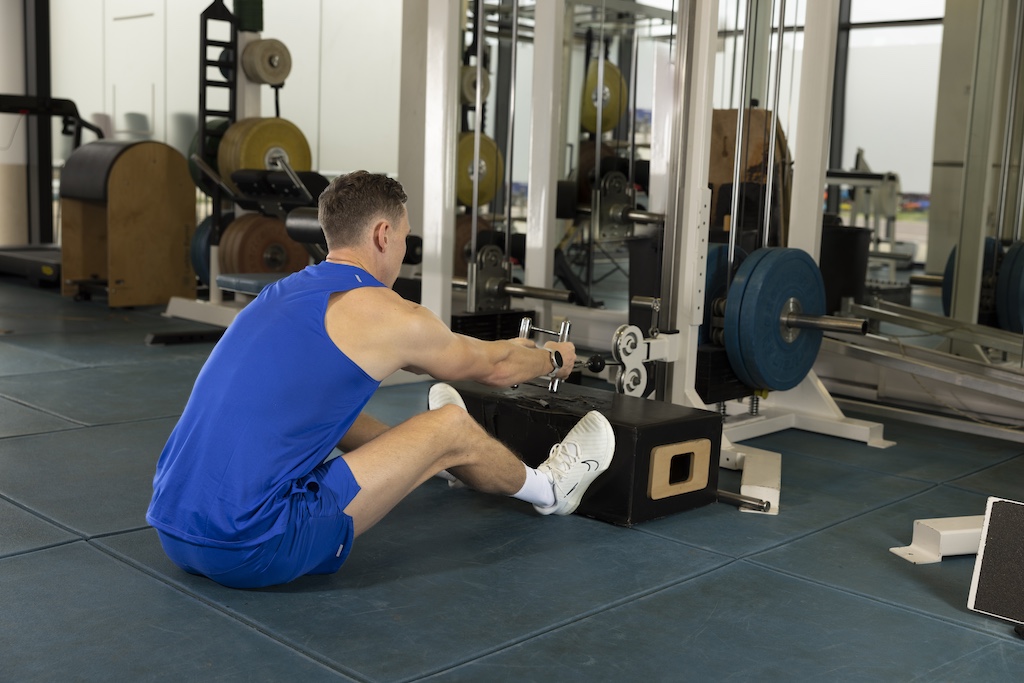
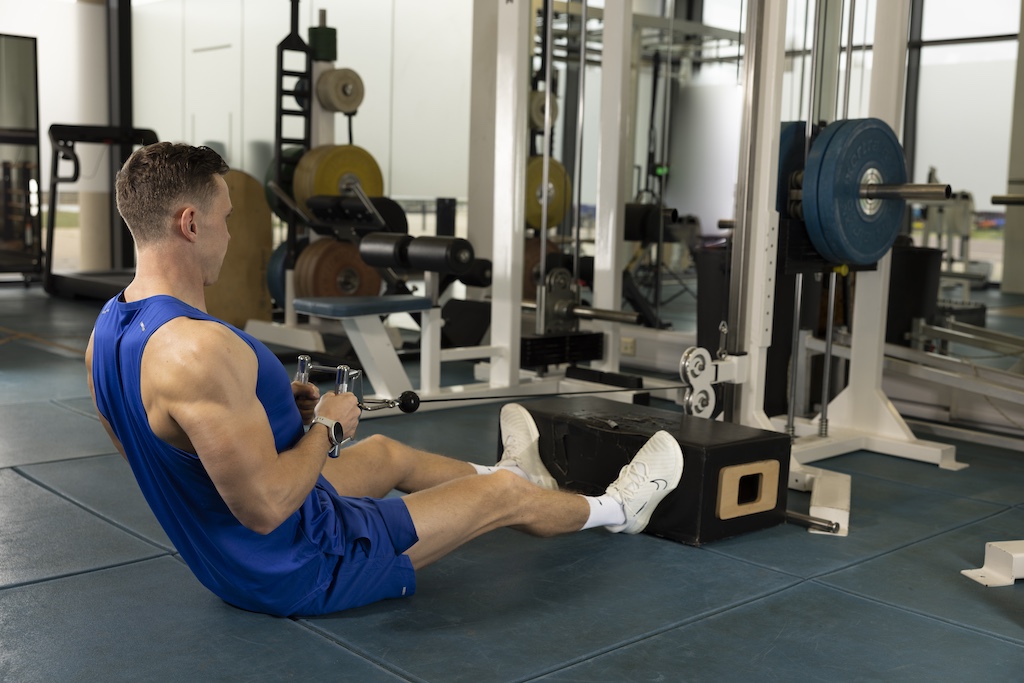
7. Seated cable row
Reps: 8
Sets: 4
Rest: As needed
- Sit on the seated cable row machine with your feet securely placed on the footrests and your knees slightly bent. Grab the handle with both hands, keeping your back straight and your torso upright
- Pull the handle towards your abdomen by retracting your shoulder blades and driving your elbows straight back. Keep your chest up and avoid leaning back excessively
- Slowly extend your arms back to the starting position, allowing your shoulder blades to protract while maintaining a slight bend in your knees and keeping your back straight
Coaching cue: Pull the handle towards your belly button, focusing on squeezing your shoulder blades together and keeping your chest up, with a controlled and steady motion.
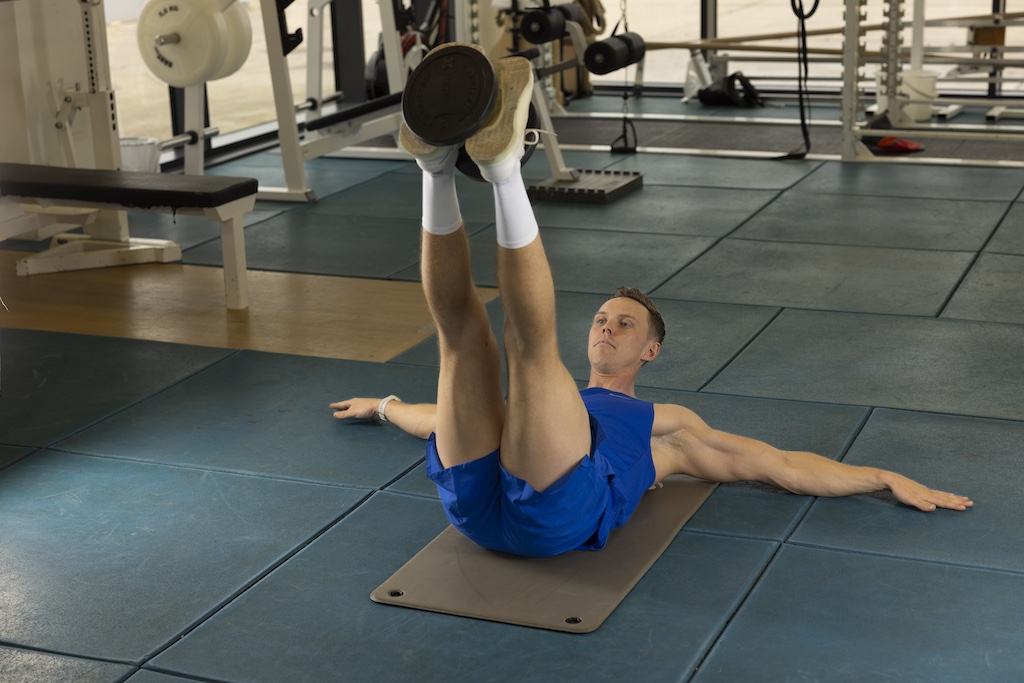
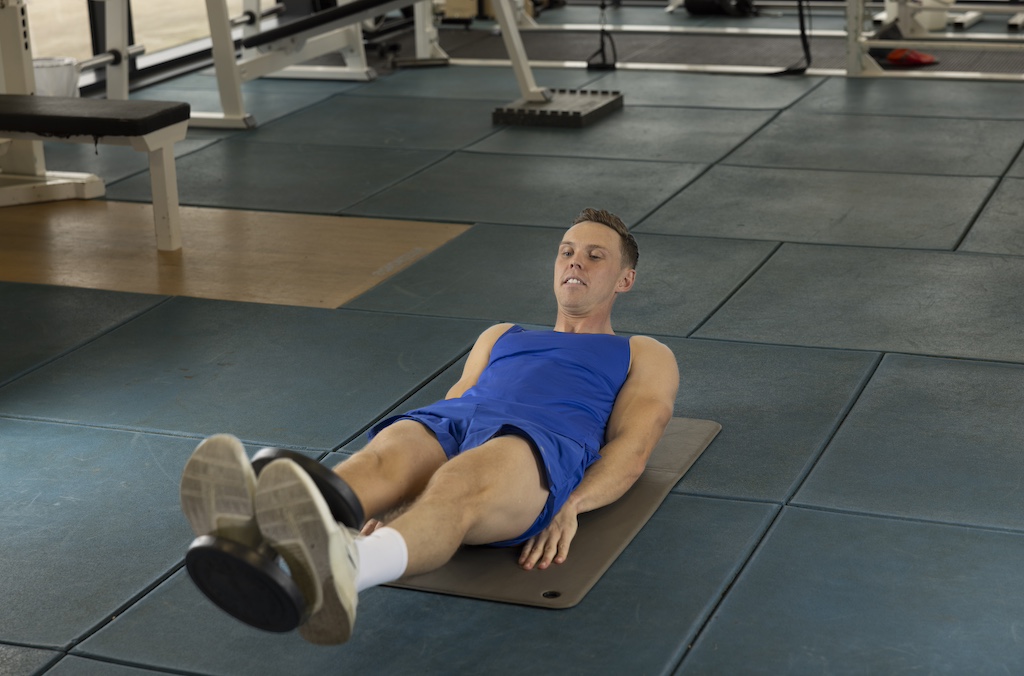
SUPERSET 1:
8. Lying leg raise
Reps: 12
Sets: 3
Rest: Move straight onto 9
- Lie flat on your back on a mat with your legs extended and your arms by your sides. Keep your lower back in contact with the mat to maintain core tension
- Engage your core and lift your legs together until they form a 90-degree angle with your torso, keeping them straight and avoiding any bend at the knees
- Slowly lower your legs back down to just above the mat, maintaining control and tension in your abs without letting your lower back arch off the floor
- Repeat the movement without letting your feet touch the ground
Coaching cue: Keep your lower back pressed into the mat and lift your legs slowly, focusing on using your core muscles.
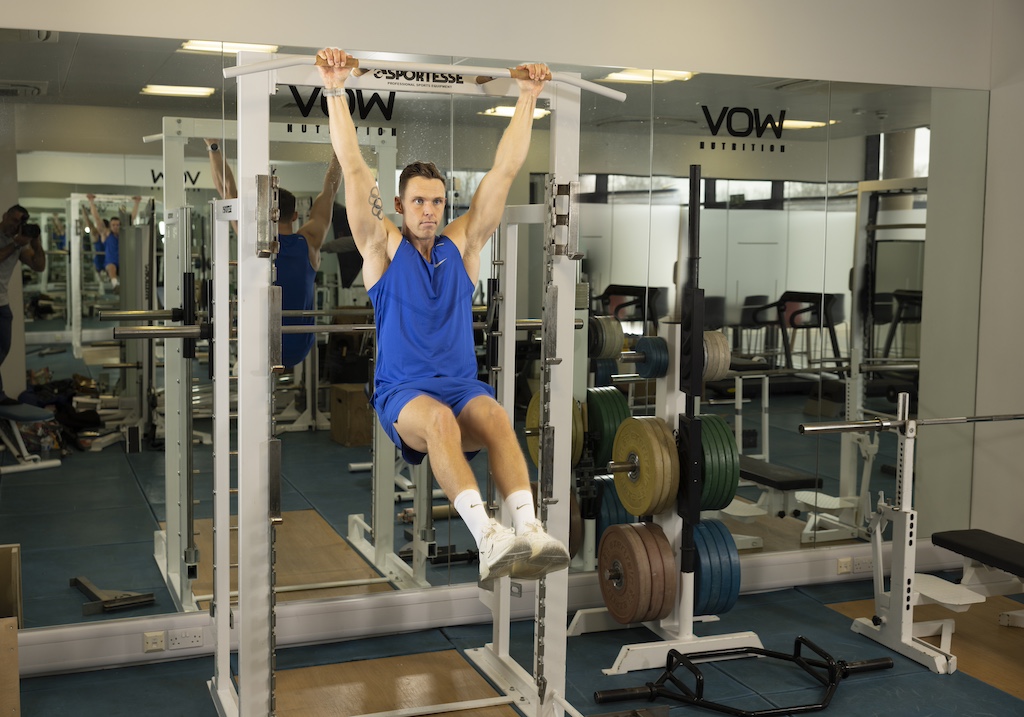

9. Hanging leg raise
Reps: 12
Sets: 3
Rest: As needed, then repeat 8
- Hang from a pull-up bar with a shoulder-width overhand grip, keeping your body straight and your core engaged
- Raise your legs together in a controlled manner until they reach a 90-degree angle with your torso, keeping them straight and avoiding any swing. Focus on using your lower abs to lift
- Slowly lower your legs back to the starting position, maintaining control and avoiding any momentum or swinging. Keep your core engaged throughout the movement
Coaching cue: Keep your body still and lift your legs by engaging your core, moving slowly and deliberately to avoid swinging.
Too difficult? If you can’t raise your legs without swinging, perform hanging knee raises instead.

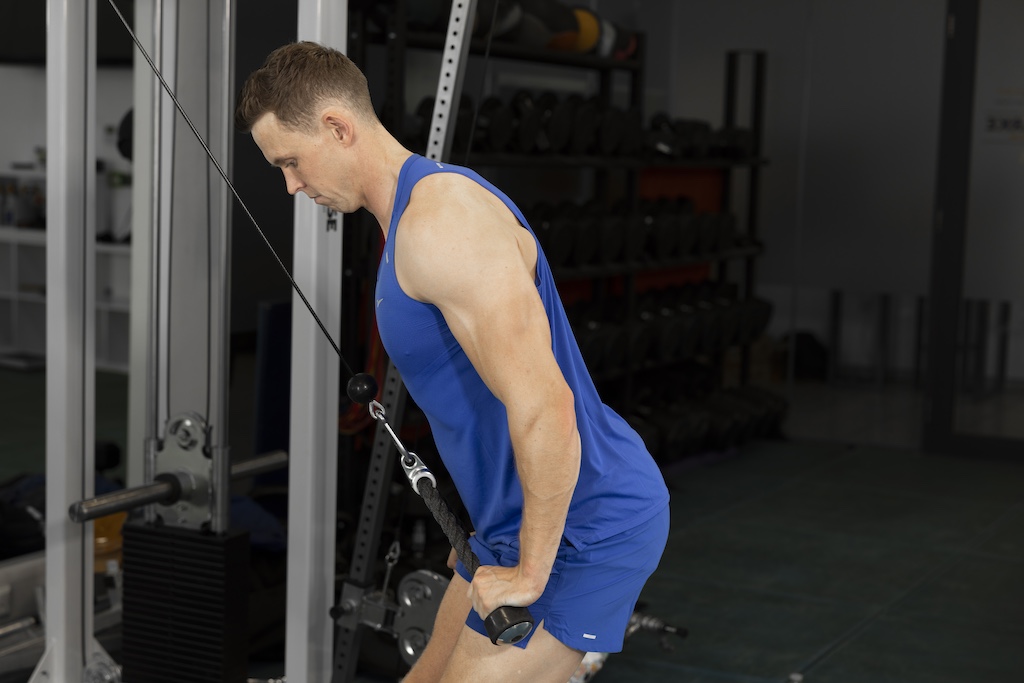
SUPERSET 2:
10. Triceps rope pushdown
Reps: 12
Sets: 3
Rest: Move straight onto 11
- Attach a rope handle to the high pulley of a cable machine. Stand facing the machine with a slight forward lean, feet shoulder-width apart, and grasp the rope with an overhand grip, elbows close to your sides
- Push the rope down by extending your elbows fully while keeping your upper arms stationary
- Slowly allow the rope to rise back to the starting position by bending your elbows, maintaining control and keeping your upper arms fixed by your sides
Coaching cue: Split the rope apart at the bottom of the movement to maximise triceps contraction.
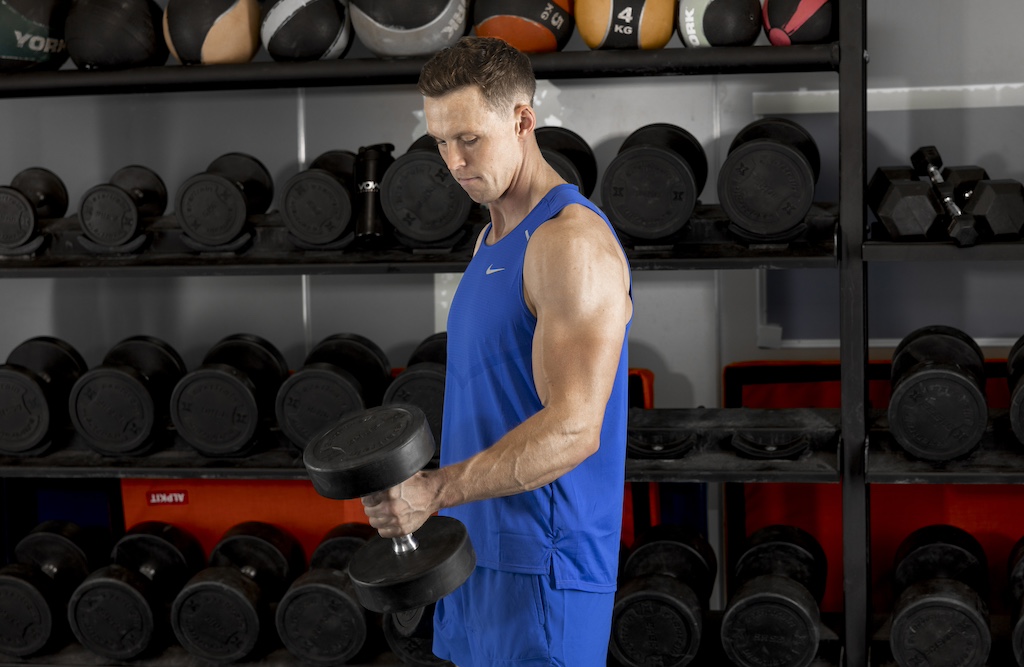
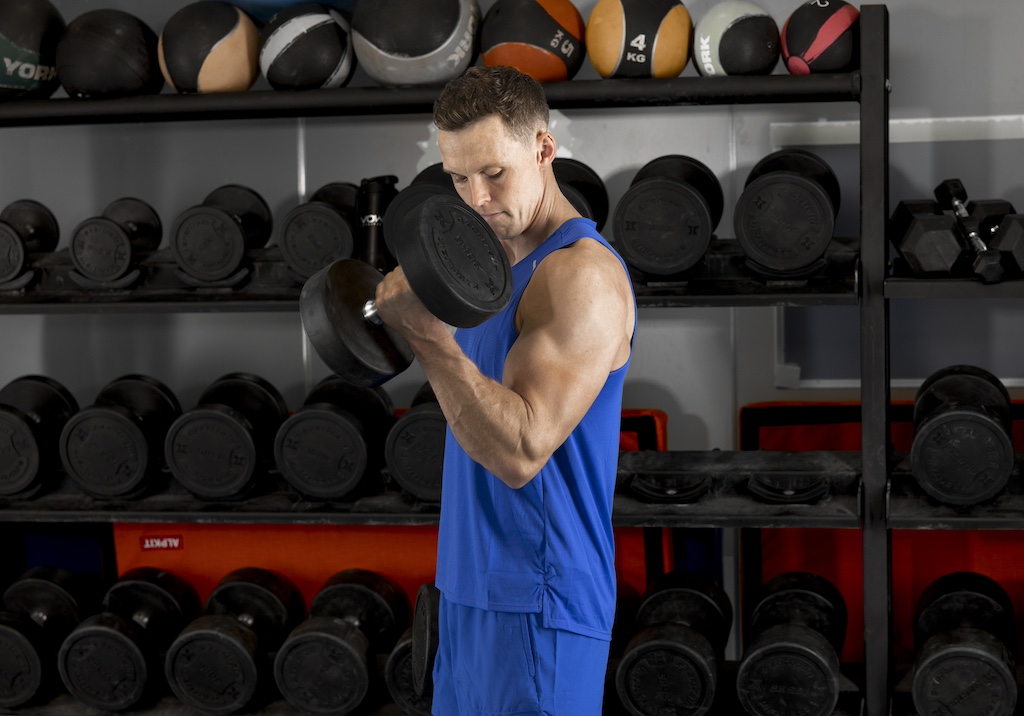
11. Dumbbell biceps curl
Reps: 8
Sets: 3
Rest: As needed, then repeat 10
- Stand with your feet shoulder-width apart, holding a dumbbell in each hand with an underhand grip (palms facing forward). Keep your arms fully extended and close to your sides
- Curl the dumbbells up by bending your elbows, keeping your upper arms stationary. Focus on squeezing your biceps at the top of the movement
- Slowly lower the dumbbells back to the starting position, fully extending your arms while maintaining control and avoiding swinging
Coaching cue: Keep your elbows close to your sides and curl the dumbbells up smoothly, focusing on squeezing your biceps at the top.
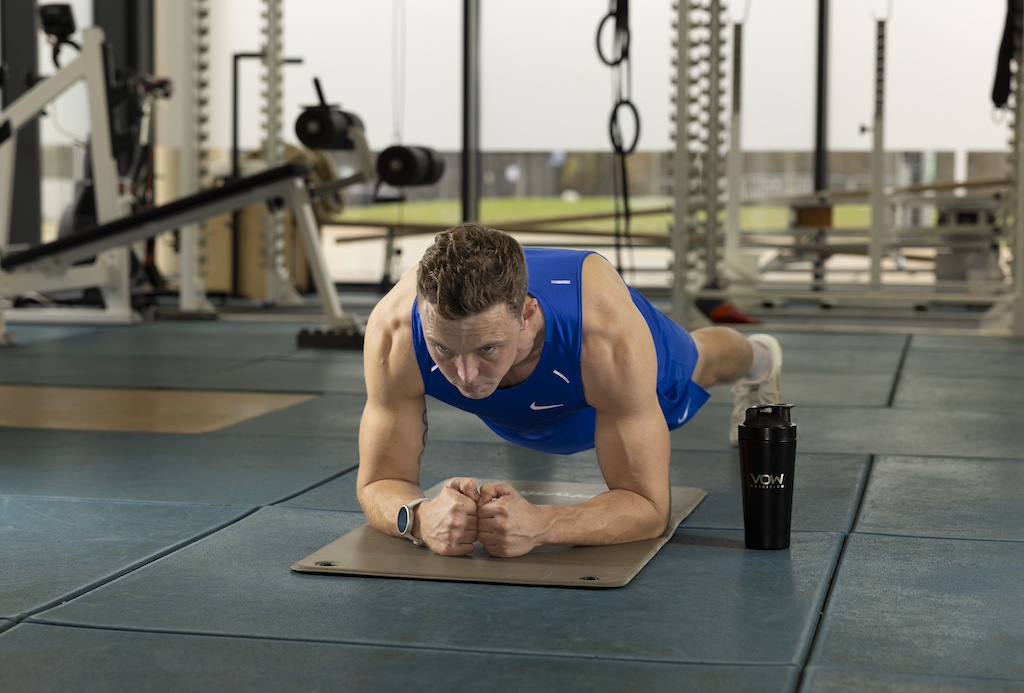
12. Plank
Hold: 60 secs
Sets: 3
Rest: As needed
- Start in a push-up position with your hands directly under your shoulders, elbows straight, and toes on the ground. Keep your body in a straight line from head to heels
- Engage your core muscles by pulling your belly button towards your spine and squeezing your glutes. Maintain a neutral neck position by looking at the floor
- Hold this plank position – just one of many plank variations – for the desired duration, focusing on keeping your body stable and resisting any sagging or arching
Coaching cue: Breathe deeply and evenly throughout.
Joe Clarke is double World Champion and VOW Nutrition ambassador. He will be representing Team GB in the 2024 Paris Olympics.

